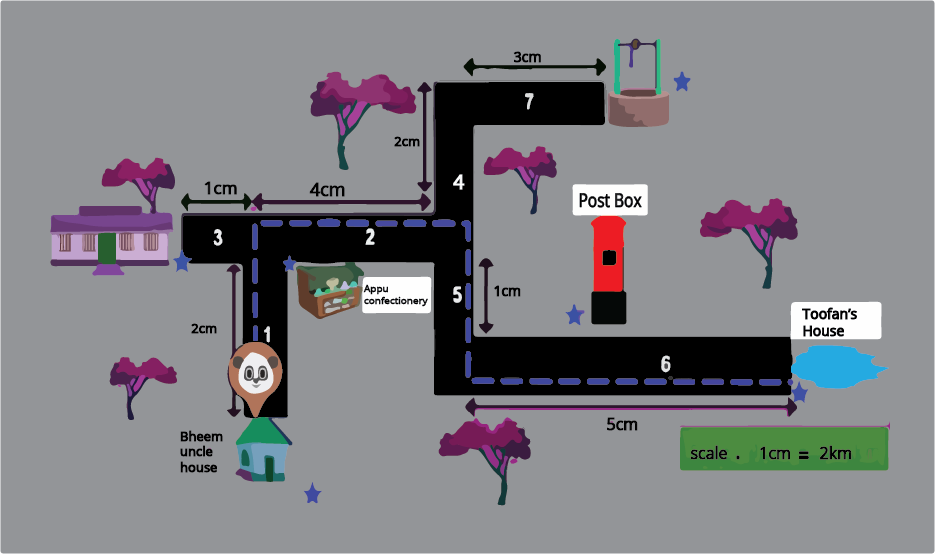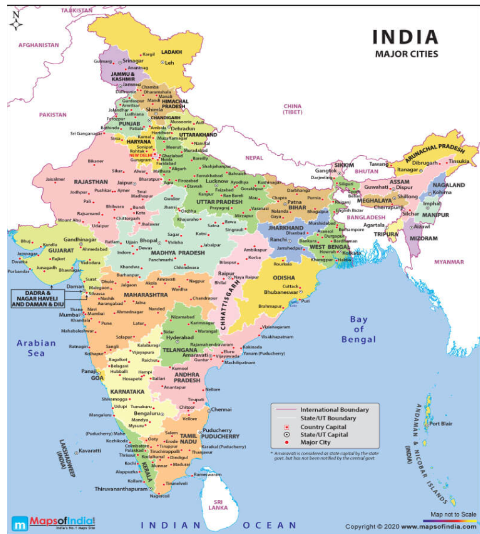Class 5 Maths Chapter 8 Summary Notes PDF Download
FAQs on Mapping Your Way Class 5 Maths Chapter 8 CBSE Notes - 2025-26
1. What is the main purpose of using a scale in the chapter 'Mapping Your Way'?
The main purpose of a scale on a map is to accurately represent a large real-world area on a small piece of paper. It shows the relationship between a distance measured on the map and the actual distance on the ground. For example, a scale like '1 cm = 5 km' helps you quickly calculate that a 4 cm line on the map equals an actual distance of 20 km. This is a key concept in the CBSE Class 5 Maths Syllabus.
2. How can I quickly revise the key concepts in Class 5 Maths Chapter 8, Mapping Your Way?
For a quick revision of this chapter, focus on these three core concepts:
- Scale: Understand how to use the given ratio (e.g., 1 cm = 10 km) to convert map distance to real distance.
- Directions: Be clear about the four main directions (North, South, East, West) and how to determine routes based on them.
- Symbols: Learn to read the map's key or legend to quickly identify landmarks like hospitals, schools, or rivers.
3. What is the difference between the distance on a map and the actual ground distance?
The distance on the map is the small measurement you can take with a ruler between two points on the paper. The actual ground distance is the real-world distance between those two locations. You use the map's scale to convert the map distance into the actual ground distance. For a deeper understanding of distance calculation, you can explore the distance between two points formula in higher classes.
4. What are the essential elements I should look for to quickly understand any map?
To quickly understand a map's summary and purpose, look for these four essential elements:
- The Title: It tells you what the map shows (e.g., 'Map of India').
- The Scale: It helps you calculate real distances.
- The Key/Legend: It explains what the different symbols and colours mean.
- The Compass Rose: It shows the primary directions (North, South, East, West).
5. Why is it important to understand the 'top-view' perspective when reading a map?
Understanding the top-view perspective is crucial because maps show us the world as if we are looking down from directly above. This view allows us to see the layout of roads, buildings, and rivers in relation to each other clearly. A side view would hide objects behind others, making it impossible to create an accurate route or understand an area's complete layout.
6. If a map shows a winding road, how can you measure its length more accurately than with a straight ruler?
Using a straight ruler for a winding road is inaccurate as it doesn't account for curves. A better method for a quick revision exercise is to use a piece of thread. Carefully lay the thread along the entire winding path on the map. Then, straighten the thread and measure its length against a ruler. Finally, use the map's scale to convert this measurement into the actual road distance.
7. How do symbols make a map a powerful tool for communication?
Symbols act as a universal visual language on a map. Instead of writing out words like 'hospital' or 'school', simple icons are used. This makes the map easy to understand for people from different places, keeps it from getting cluttered, and allows a lot of information to be presented clearly in a small space. You can learn more about how symbols help in reading maps to master this concept.
8. How does 'Mapping Your Way' connect to other Maths topics taught in Class 5?
This chapter is a practical application of several other Maths concepts.
- Multiplication and Division: Used when converting distances with the map scale.
- Geometry: Concepts of shapes, area, and boundaries are used when looking at states or countries on a map.
- Measurement: The entire chapter is based on the concept of measuring length and converting units.





























